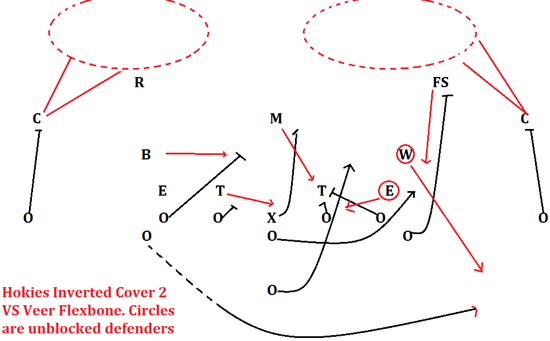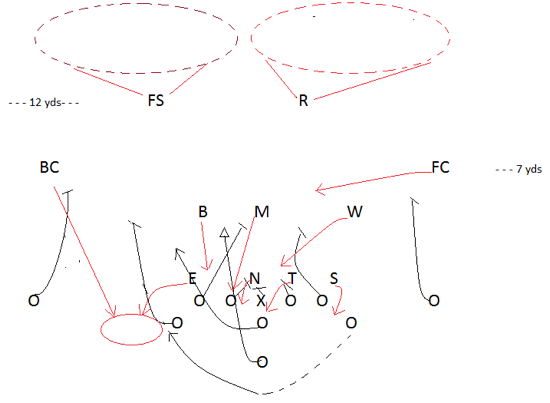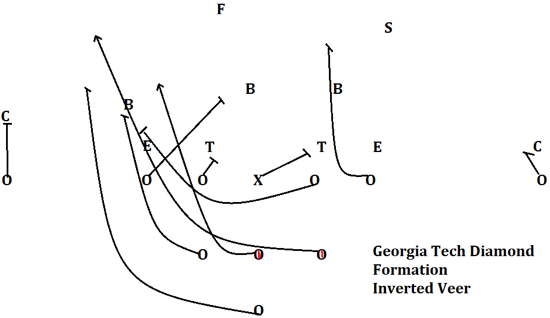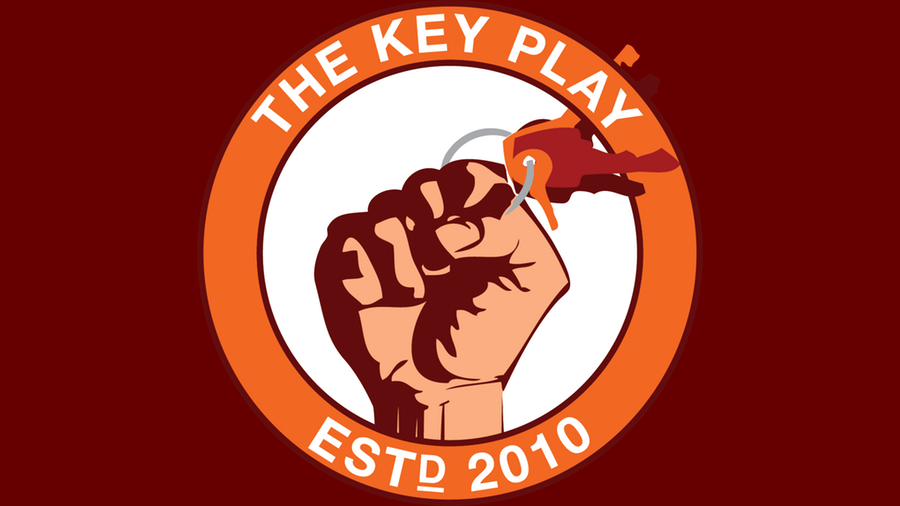While many loath Paul Johnson's chop blocking, veer oriented, flexbone offense, I circle the date of the Georgia Tech game on my calendar every as the opponent I most fear. Johnson's troops may tread the line on the ethics of blocking, but their offensive line plays a pure form football, one that I was taught: the low man, not big man wins. Explode off the ball at the snap. Create seems in the defense and exploit them with quick hitting, hard running plays that emphasize will more than talent. It is beautiful football, and it's damn frustrating to see it well executed against our Hokies.
Even though Paul Johnson's system is terrific, perhaps no coach has had more success in stopping the flexbone offense than Bud Foster. Johnson has only defeated the Hokies one time in five tries since taking over the Yellow Jackets program, and despite posting impressive yardage totals, the Hokies have been able to limit big plays and force turnovers.
Foster has tweaked his approach against Georgia Tech over the years, but several things have been consistent.
- The Hokies will overcommit to stop the fullback ("A" back) dive on the triple option.
- On MOST triple option plays, the unblocked defender will take the pitch forcing the quarterback to keep the ball. Foster's approach assumes that, while the quarterback will get yardage, he will also take a pounding and start making poor reads as the game progresses. The quarterback tends to be less of a big play threat, as he is closer to the pursuit of the defense than the pitchman.
- The secondary usually plays a cover-2 with the corners as run support, or inverted cover-2 with both safeties coming forward in run support and each corner taking a deep half.
Inverted Cover-2 Against Veer:

Cover-2 Against Veer:

I have reviewed the basics of the triple option offense and the different ways Bud Foster has tried to stop it in previous articles. I strongly encourage you to review my piece from last season.
Enter Vad Lee
It's hard to believe after all the grief the Yellow Jackets have caused the Hokies, but in the last couple of matchups Paul Johnson has had one arm tied behind his back. Tevin Washington was almost inept as a passer, and his slight stature played directly into Foster's defensive approach of encouraging the quarterback to keep the ball and to be pounded until he starts making poor reads at the end of the game. In 2011, Foster's commitment to having the quarterback beat him, albeit with his legs, resulted in Washington carrying the ball 24 times for 115 positive yards (77 net). No other Georgia Tech ball carriers had more than 8 carries. As the game progressed, Washington began to make poor reads, seemingly in an effort to avoid contact. On the critical drive of the fourth quarter, Washington was stopped on the midline option on 3rd and 4th down deep in his own territory. On both plays, he had an opportunity to push the pile, but didn't have the legs or the will after being pounded the whole game.
Durham, North Carolina native Vad Lee is running point now. Lee is not as physically imposing as Josh Nesbitt, but he has great acceleration and is a big body that can take a pounding. Perhaps more impressively, he can be a dangerous down the field threat from play-action, so much so that Paul Johnson uses some pistol formation to go with his flexbone set. His ability allows Johnson to open up his playbook. While to the naked eye, it appears that the Wreck is running boring option after option, the Yellow Jackets run a wide variety of plays all based on veer principles.
A review of the Yellow Jackets demonstrates how challenging it is for a defense to stop this offense. On a series of two back-to-back scoring drives, the Yellow Jackets ran every basic form of running play in their offense, without running the play more than twice over the course of two long drives (with the exception of two plays from the pistol.) Let's take a look.
First, Lee gives to the fullback on a triple option.
Here Lee runs a counter option, which only involves a read on one unblocked man.
On short yardage, the Yellow Jackets come back with a quick toss. The Hokies have struggled to defend this in short yardage and goal line situations in the past.
Lastly, Lee runs the midline option. Johnson loves this play on the goal line or short yardage. The fullback dives at a wider aiming point. The quarterback fakes a give, and then follows the fullback like a lead blocker into the hole.
In the past, the Hokies have been able to load up on the run with nine men in the box because Georgia Tech's passing attack was so inept. It is hardly a sophisticated look, but most of their passing principles are very similar to Marshall's and East Carolina's. The difference is that the slot receivers are the wingbacks, and the Yellow Jackets look to take advantage of the safeties flying forward in run support and hit the big play deep to those wingbacks rather than attack the flat. Georgia Tech also has two big bodies at wide receiver, so the Calvin Johnson-ish jump ball scenario can loom large.
Georgia Tech's favorite passing play is a basic split end post, slot wheel route combination. The big split end runs a post pattern and either picks the interior defender, or heads to the post where there is likely not safety help. The wingback heads to the flat, then wheels up the field looking to catch the linebacker or safety moving east-west, rather than being able to turn and run.
The Yellow Jackets also use the basic quick screen and tunnel screen, and then run vertical routes off that action. Here, the Yellow Jackets come out in a twins right formation. The wingback and the split end go vertical, and the wingback is wide open for a touchdown and drops the ball.
If you rewatch the play, the receiver running in the flat on the screen action is wide open on the play. If the wingback had been covered, Lee could have turned to his safety valve for a nice chunk gain.
A New Wrinkle
The other new trick in Johnson's arsenal is running inverted veer from the pistol. Conceptually, it is a very similar play to that the Hokies used on the game winning touchdown versus Miami in 2011.

Let's watch the Yellow Jackets run this for big yardage against Duke.
On the inverted veer, the fullback aligns behind the quarterback, with a wingback to each side in the pistol. At the snap, the play side of the offensive line all blocks to their inside gap. If a defensive lineman isn't filling that gap, then the lineman will continue on the same path (as if on train tracks) and cut the first linebacker pursuing from the inside. The defensive end has been instructed to bump the tackle as he goes inside to squeeze down the dive, but in doing so he essentially takes himself out of the play. The play side wing back leads up and cuts the outside linebacker. The fullback sprints out ahead of the quarterback and cuts the first blue shirt to cross his face. The right guard pulls play side, and kicks out the end if he stays wide, or tries to get outside of him and turn up if he crashes.
The quarterback takes a belly step and creates a mesh point with the right wingback, who is running across his face. On most read options, the quarterback is the wide threat, but here, he is the dive and the wingback is the wide threat. If the end crashes, the quarterback gives to the wingback. If the end stays wide, the pulling guard traps him and the quarterback should have a huge hole (see Logan's Miami game winner). Here, the end goes inside, and the wingback gets the ball for a huge gain.
The Yellow Jackets don't run this that often, but from the Duke and Elon film I watched, this was their most consistent big play generator in the running game. Against Duke, Georgia Tech ran the inverted veer six times. On five, Lee handed it to the wingback. On the sixth, he pulled the ball and threw off play action. I didn't have an opportunity to watch the North Carolina game, but it appears that this functions as a power sweep for the Yellow Jackets (similar to the sweep used by Marshall), as much as it functions as an option.
The Yellow Jackets always prove to be one of the most challenging opponents for the Hokies. No game is more physical. No game requires more emphasis on fundamental tackling and pursuit. And, with the added wrinkle of an improved passing game, no team presents a more vexing scheme to stop than Georgia Tech. The Hokies have been on the winning side of this rivalry because their scheme has prevented big plays while forcing turnovers and then getting just enough offense to get the job done. This week, the Hokies have to "re-learn" how to defend the option with only four days of practice and a tired, beaten up defensive front, and while it seems like the young corners may not factor as much against this kind of foe, one mistake over the top in a game where each possession is so critical can put the Hokies behind the eight ball in the Coastal Division.


Comments
Please join The Key Players Club to read or post comments.
Please join The Key Players Club to read or post comments.
Please join The Key Players Club to read or post comments.
Please join The Key Players Club to read or post comments.
Please join The Key Players Club to read or post comments.
Please join The Key Players Club to read or post comments.
Please join The Key Players Club to read or post comments.
Please join The Key Players Club to read or post comments.
Please join The Key Players Club to read or post comments.
Please join The Key Players Club to read or post comments.
Please join The Key Players Club to read or post comments.
Please join The Key Players Club to read or post comments.
Please join The Key Players Club to read or post comments.
Please join The Key Players Club to read or post comments.
Please join The Key Players Club to read or post comments.
Please join The Key Players Club to read or post comments.
Please join The Key Players Club to read or post comments.
Please join The Key Players Club to read or post comments.
Please join The Key Players Club to read or post comments.
Please join The Key Players Club to read or post comments.
Please join The Key Players Club to read or post comments.
Please join The Key Players Club to read or post comments.
Please join The Key Players Club to read or post comments.
Please join The Key Players Club to read or post comments.
Please join The Key Players Club to read or post comments.
Please join The Key Players Club to read or post comments.
Please join The Key Players Club to read or post comments.
Please join The Key Players Club to read or post comments.
Please join The Key Players Club to read or post comments.
Please join The Key Players Club to read or post comments.
Please join The Key Players Club to read or post comments.
Please join The Key Players Club to read or post comments.
Please join The Key Players Club to read or post comments.
Please join The Key Players Club to read or post comments.
Please join The Key Players Club to read or post comments.
Please join The Key Players Club to read or post comments.
Please join The Key Players Club to read or post comments.
Please join The Key Players Club to read or post comments.
Please join The Key Players Club to read or post comments.
Please join The Key Players Club to read or post comments.
Please join The Key Players Club to read or post comments.
Please join The Key Players Club to read or post comments.
Please join The Key Players Club to read or post comments.
Please join The Key Players Club to read or post comments.
Please join The Key Players Club to read or post comments.
Please join The Key Players Club to read or post comments.
Please join The Key Players Club to read or post comments.
Please join The Key Players Club to read or post comments.
Please join The Key Players Club to read or post comments.
Please join The Key Players Club to read or post comments.
Please join The Key Players Club to read or post comments.
Please join The Key Players Club to read or post comments.
Please join The Key Players Club to read or post comments.